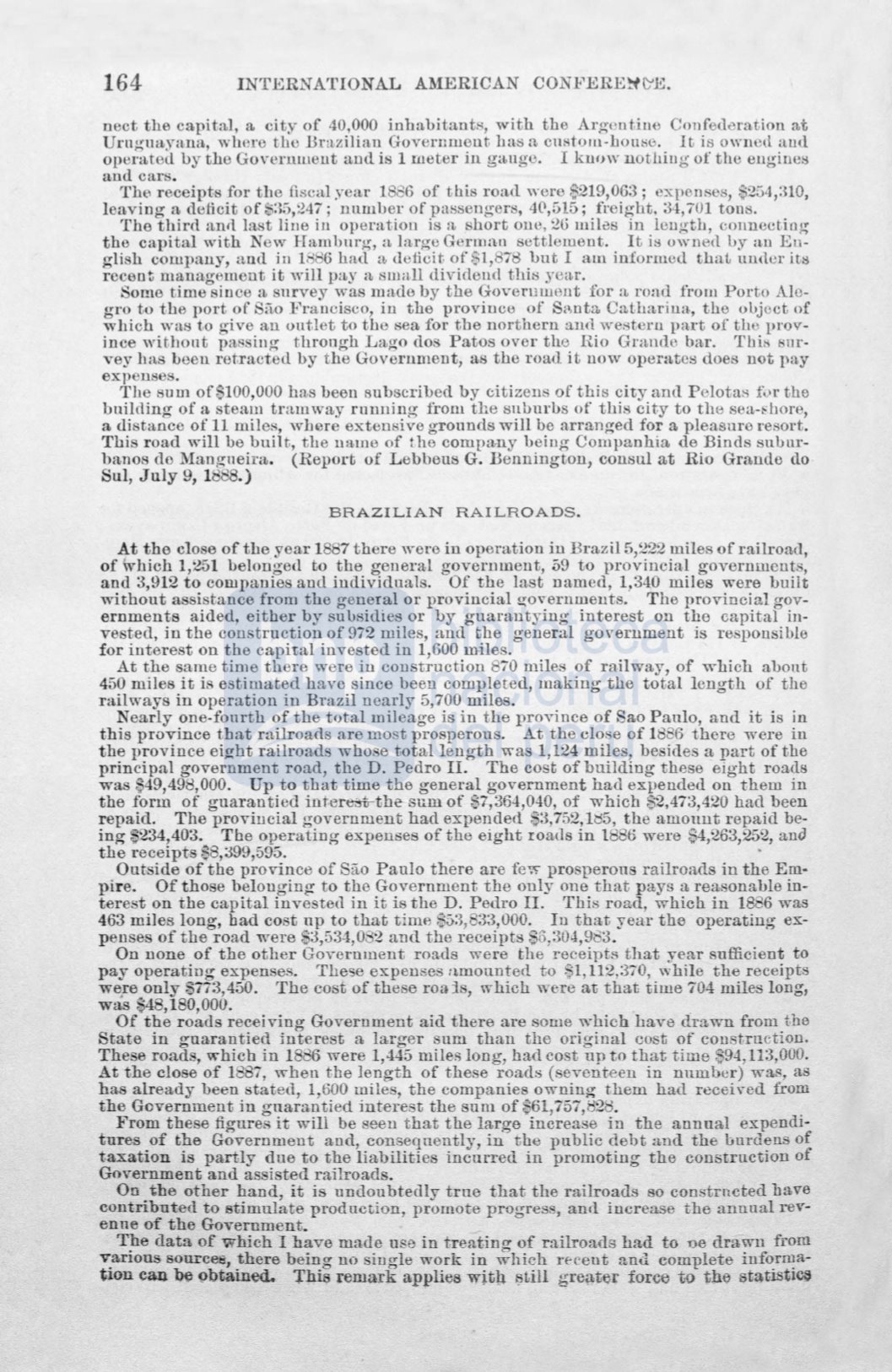

164-
INTERNATIONAL AMERICAN
CONl''ERE~C'E.
nect the capital, a city of 40,000 inhabitants, with the Argcntine Confedoration at
UrnguaJ ana, whore tho Brazilian Goveruruent has
n.
cnstom-bou~<>.
It
is owne<l aud
operated
by
the Govenuuent and is 1 meter in ga.ngc.
I
know uotlüug of the
engiue~
a.ndcars.
Tbe receipts for the fiscal.vear
1886
of this road were $219,063; expenses, $254,:310,
leaving a deticit of
~~5,247;
number of passengers, 4(1,515; freight. 34,701 tons.
Tbe third anillast line in operatioo is a short one, 26 miles in lcugtb, conncctiog
tbe capital with New Hambnrg, a largo Germau settlement.
It
is owned by an Eu–
glish company, and in 1:
6
had a deficit of $1,878 lmt
I
am informcd that
und.erits
rccent management it will pay
a
swall dividend thi:; ye<tr.
Sorne time since a snrvey was made by the Goveruwent :for
a
road fi·ow Porto Ale–
gro to the port of Sao Francisco, in the proviuce of SP,nta Catbarina, tbe olJject of
which was to give an outlet to tbc sea for tbe northern aucl western part of tbe prov–
ince wit.hout passi11g through Lago dos Patos over the Río Grande bar. Tbis sm–
vey has beeu retracted by the Goverument, as the road it now operatcs does not pay
expenses.
The su
m
of$100,000 has beeu subscribed by citizens of this city and
Pelota~
f.,•r
the
building of
a
steam trmnway ruuning from the snburus of this city to the sea-Ehore,
a distance of 11 miles, wbere extensive grounds will be arranged for a pleasure resort.
Thi road willlJe built, tlte uame of the company being Companhia de Binds sulJur–
lJanos de Mangneira. (Report of Lebbeus G. Ben ington, consul a.t Rio Grande do
Snl,
J
uly
9,
18 8.)
BRAZILIAN RAILROADS.
At the
el
ose of tbe year 1887 there were in operation in Bra.zil5,:t22 miles of railroad,
of which 1,251 belonged to the general government,
59
to provincial goveruments,
a.nd3,912 to companies
a.ndiudividuals. Of the last named,
1~340
miles were built
without assistance from the general or provincial goverumeuts. Tbe provincial gov–
eruments aided, either by suusidies or by guarautying interest on the capital in–
ve ted,
in
tbe con truction of 972 miles, ancl
~be
general government is re ponsible
for interest on the capüal invested in 1,600 miles.
At the same time there were in coustruction 870 miles of railway, of which about
450 miles it is estirualied have since been completed, makiug the total length of tbe
r ailways in operation in Brazilnearly 5,700 miles.
Nearly one-fourth of the total mileage is in the province of Sao Paulo, and it is in
this province that ntilroads are most prosperous. At tbe close of 1886 there were in
the pr O\TÍnce eight railroads wbose totalleugtb was 1,124 miles, besides
a
part ofthe
principal government road, the
D.
Pedro
II.
The cost ofbuilding these eight roads
was 49,498,000. Up to that time the general goverument
had
expended on them in
the form of guarautied
inter~tbe
sum of $7:,364,040, of whicb $"2,473,420 hacl been
repaid. Tbe proviucial government had expended $3,752,1ts5, the amonnt repaid be–
ing 234,403. The operating expenses of the eight roads in
1886
were 4,263,252, ana
the receipts
$8,~99,595.
Out ·ide of the province of Sao Paulo there are fe'.'> prosperons railroads in the
E
m–
pire. Of those belonging to the Governmeut the ouly oue that pays a reasonable in–
t er est on the capital invested in it is tbe
D.
Pedro
II.
This road, whicb in 1886 was
463 miles long, bad cost np to that time $53,833,000. lo tbat year the operat.ing ex–
penses ofthe road were $3,534,0 2 aud the receipts $6,:304,9 ' 3.
On none of the other Government roads were tbe receipts that year sufficient to
pay operatiug expenses. These expen¿es nmounted to . 1,112,370, while the receipt
w~re
only 8773,450. The cost of the e roai , which were at that tiwe 704 miles long,
wa-s $48,180,000.
.
Of the r oads receiving Government aid there are some whicb have drawn from the
State in guarantied jnterest a larger sum than the original cost of con truction.
These road , which in 18
6
were 1,445 mile5long, had cost up to that time
S94,
113,000.
At the close of 1 87, wben the length of these road:,; (seventeeu in number) was, as
has already been stated, 1,600 miles, the companies owning them had recei,-ed from
the Government in guar:mtied interest the sum of$61,757,'
2!:i.
From these figures it will be seen that tbe large increase
in
the anuual expendi–
tu-res of the Government and, consequently, in be pnblic deht
a.ndthe bun1eus of
taxation
is
partly due to the liabilities incurred in pmmoting the construction of
Governmeut and assisted railroads.
On the other hand, it is undoubtedly true that the railroads so constrncted bave
contributed
to
stimulate production, promote progress, aml increase the annnal rev–
en
ne
of the Government.
T_he data of which
1
have made use in treatiug of railroads had to ue drawn from
v:anons sources, there being
no
·ingle work in which
r~ceut
am:l
complete
inforn~a
tiOn
can
be
<>btained.
l'his
remark applies
wjtp
~Lill
grep.ter force
to the
statistws
















